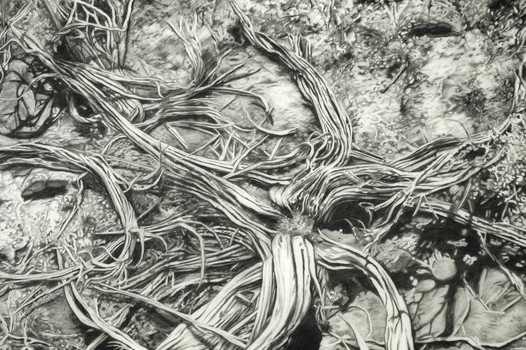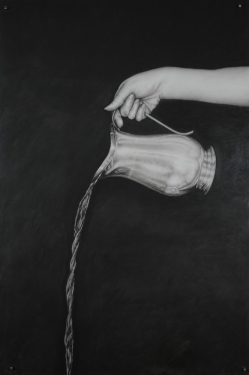Might one approach the too-vast sublime through looking at the specifics of landscape up-close? And might studying a small plot of land help us to see the splendor of the greater world more clearly?
Instead of focusing on grand vistas and majestic skyscapes, I have turned my gaze down towards the earth, drawn to mundane scenes of decay and regeneration. There are no fast approaching storms here, no dazzling sunsets, and yet these spaces are neither uneventful nor unremarkable: rather, they mark the day-to-day erosion and regeneration of matter bound by time, the “sublime” they express is one tempered by the abject.
The organic forms embody the cyclic process of life, capturing the transition from a state of growth to one of dissolution and then, once again, regeneration. I find their dis-order to be filled with movement, pattern, and grace. First, I photograph the plants, creating “panoramic” views of the northeastern forest floors. Later, working from the photographs in my studio, I draw the organic systems, exploring the tensions between pattern and complexity, beauty and chaos.
Instead of focusing on grand vistas and majestic skyscapes, I have turned my gaze down towards the earth, drawn to mundane scenes of decay and regeneration. There are no fast approaching storms here, no dazzling sunsets, and yet these spaces are neither uneventful nor unremarkable: rather, they mark the day-to-day erosion and regeneration of matter bound by time, the “sublime” they express is one tempered by the abject.
The organic forms embody the cyclic process of life, capturing the transition from a state of growth to one of dissolution and then, once again, regeneration. I find their dis-order to be filled with movement, pattern, and grace. First, I photograph the plants, creating “panoramic” views of the northeastern forest floors. Later, working from the photographs in my studio, I draw the organic systems, exploring the tensions between pattern and complexity, beauty and chaos.
Sage Drawings. 2012-present. When I first arrived in Taos, New Mexico a few years ago for an artist fellowship at the Helene Wurlitzer Foundation I had never worked with landscape before. While hiking the high desert, I became fascinated with the forms of eroding sagebrush. The serpentine forms embody the entropic process, capturing the transition of these plants from a state of growth to one of dissolution. I begin by photographing the plants, turning my gaze downward towards the ground to create panoramic views of the desert floor. Later, working from the photographs in my studio, I draw the organic systems, exploring the tensions between pattern and complexity, beauty and chaos. In the earlier pieces (from 2012-2014), I cropped the images so that the forms are abstracted and ambiguous, reminiscent of biological systems like plant roots and blood vessels. These drawings are done on translucent mylar, and some are layered with other drawings and/or archival ink jet prints. I experimented with ways of installing the drawings that reinforce the depth of the tangled, twisted shapes, the organic forms both resisting and contained by the rectangular mylar panels and the grid-like structures of the installation formats. I’m currently working on a series of large-scale (42x96 inches) landscapes that have been developed in relation to the Romantic notion of the sublime and 19th century landscape painting. These are more realistic than the earlier drawings, and focus on landscape as mundane spaces rather than the grand vistas of the tradition with which we are familiar. Life-size details of the New Mexican high desert floor depict entropic spaces comprised of eroding sagebrush, weeds, and soil, referencing decay and deterioration, while also embodying the beauty of the organic patterns. I see these drawings as subverting Western constructs of the landscape genre, and specifically in tension with aspects of the Romantic sublime through their focus on mundane and abject spaces. There are no fast approaching storms here, no dazzling sunsets and yet these spaces are neither uneventful nor unremarkable in their mundanity. Rather, they mark the day-to-day erosion of a materiality bound by the temporal and perhaps bring us closer to landscape as memento mori. In this way, my current drawings explore the connections between the sublime and the abject, the spaces evoking what might best be described as the “underside” of the sublime and, as such, they might be considered awe-inspiring, perhaps even terror-producing, as nature reminds us that we, like all things, are mortal. The size of these drawings is important as they must be large enough to be perceived as being within the very tradition of the genre they seek to subvert. Like an Albert Bierstadt painting of Yosemite Valley, the drawings visually surround the viewer, encompassing her in the fullness of the panoramic space that a traditional landscape embodies, even while these particular landscapes depict close-up views of the desert floor. It is in exploring the boundaries, tensions, and contradictions of these “humbler” spaces in relation to the grand tradition that I feel I might seek a sense of the contemporary sublime.
Half Empty/Half Full. 2011. 24"X36". Charcoal and graphite on mylar.






